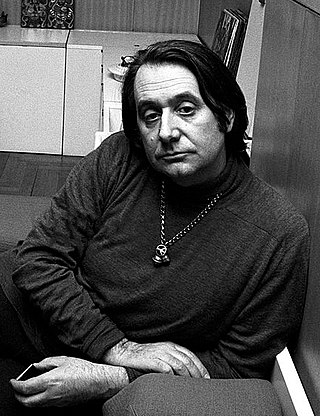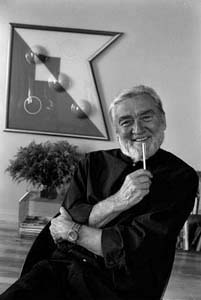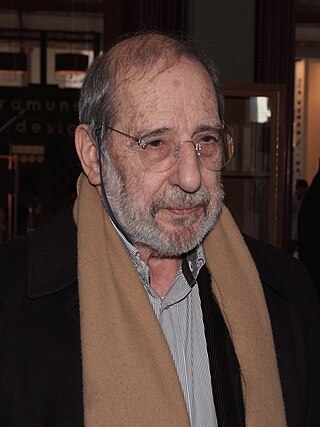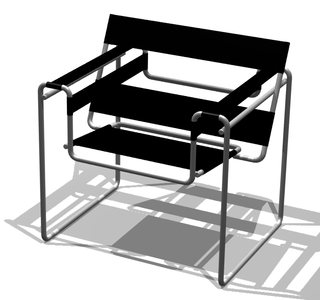
Ettore Sottsass was a 20th-century Italian architect, noted for also designing furniture, jewellery, glass, lighting, home and office wares, as well as numerous buildings and interiors — often defined by bold colours.

Verner Panton is considered one of Denmark's most influential 20th-century furniture and interior designers. During his career, he created innovative and futuristic designs in a variety of materials, especially plastics, and in vibrant and exotic colors. His style was very "1960s" but regained popularity at the end of the 20th century. As of 2004, Panton's best-known furniture models are still in production.

Dame Zaha Mohammad Hadid was an Iraqi-British architect, artist and designer, recognised as a major figure in architecture of the late-20th and early-21st centuries. Born in Baghdad, Iraq, Hadid studied mathematics as an undergraduate and then enrolled at the Architectural Association School of Architecture in 1972. In search of an alternative system to traditional architectural drawing, and influenced by Suprematism and the Russian avant-garde, Hadid adopted painting as a design tool and abstraction as an investigative principle to "reinvestigate the aborted and untested experiments of Modernism [...] to unveil new fields of building".

Álvaro Joaquim de Melo Siza Vieira is a Portuguese architect, and architectural educator. He is internationally known as Álvaro Siza and in Portugal as Siza Vieira.
Shiro Kuramata is one of Japan's most important designers of the 20th century.

Vitra is a Swiss family-owned furniture company with headquarters in Birsfelden, Switzerland. It is the manufacturer of the works of many furniture designers. Vitra is also known for the works of notable architects that make up its premises in Weil am Rhein, Germany, in particular the Vitra Design Museum.

The Vitra Design Museum is a privately owned museum for design in Weil am Rhein, Germany.

Alexander Girard, affectionately known as Sandro, was an architect, interior designer, furniture designer, industrial designer, and a textile designer.

Knoll is an American company that manufactures office systems, seating, storage systems, tables, desks, textiles, and accessories for the home, office, and higher education. The company is the licensed manufacturer of furniture designed by architects and designers such as Harry Bertoia, Ludwig Mies van der Rohe, Florence Knoll, Frank Gehry, Charles Gwathmey, Maya Lin, Marcel Breuer, Eero Saarinen, and Lella and Massimo Vignelli, under the company's KnollStudio division. Over 40 Knoll designs can be found in the permanent design collection of the Museum of Modern Art in New York City.

Bernice Alexandra Kaiser Eames was an American artist and designer who worked in a variety of media.

Charles Eames and Ray Eames were an American married couple of industrial designers who made significant historical contributions to the development of modern architecture and furniture through the work of the Eames Office. They also worked in the fields of industrial and graphic design, fine art, and film. Charles was the public face of the Eames Office, but Ray and Charles worked together as creative partners and employed a diverse creative staff. Among their most recognized designs is the Eames Lounge Chair and the Eames Dining Chair.
Ronan & Erwan Bouroullec are brothers noted for their design work, which has been featured in publications and museums globally — and spans a wide range from tables and chairs to tableware, rugs, textile walls, office furniture, ceramics, art objects and urban projects.

The Memphis Group, also known as Memphis Milano, was an Italian design and architecture group founded by Ettore Sottsass. It was active from 1980 to 1987. The group designed postmodern furniture, lighting, fabrics, carpets, ceramics, glass and metal objects.

The Eames Molded Plastic & Fiberglass Armchair is a fiberglass chair, designed by Charles and Ray Eames, that appeared on the market in 1950. The chair was intentionally designed for the International Competition for Low-Cost Furniture Design. This competition, sponsored by the Museum of Modern Art, was motivated by the urgent need in the post-war period for low-cost housing and furnishing designs adaptable to small housing units.

Emeco is a privately held company based in Hanover, Pennsylvania. The Emeco 1006, known as the Navy Chair, has been in continuous production since the 1940s. Today, Emeco manufactures furniture designed by notable designers and architects such as Philippe Starck, Norman Foster, and Frank Gehry.
Michele de Lucchi is an Italian architect and designer.

Zanotta is an Italian furniture company particularly known for the iconic pieces of Italian design it produced in the 1960s, 70s, and 80s. These include the "Sacco" bean bag chair and "Blow", the first mass-produced inflatable chair. The company was founded in 1954 and has its main plant in Nova Milanese. In 1984 Zanotta established its experimental division, Zabro, headed by Alessandro Guerriero, with Alessandro Mendini and Stefano Casciani. Since the death of its founder, Aurelio Zanotta, in 1991, it has been run by members of his family. Zanotta's products were awarded the Compasso d'Oro in 1967, 1979, 1987 and 2020.
Martine Bedin is a French architect and designer. She was a member of the Memphis Group.

The Vitra Fire Station is a concrete and steel building of 852 m2 (9,170 sq ft) located at the Vitra Furniture factory in Weil am Rhein, Germany. Completed in 1993, it was the first constructed project by Iraqi architect Zaha Hadid.















